While I frost most of my cakes with American buttercream, sometimes I like to mix things up! After a bit of experimenting, I feel like I have finally perfected Swiss meringue buttercream frosting (SMBC).
This type of frosting definitely takes a bit more effort and time than my American buttercream, but it is totally worth it. It’s truly a dream to pipe and frost with!
My favorite thing about Swiss meringue is that it doesn’t crust. You don’t have to cover it with plastic wrap or worry about your frosting crusting on your cake if you make it in advance.
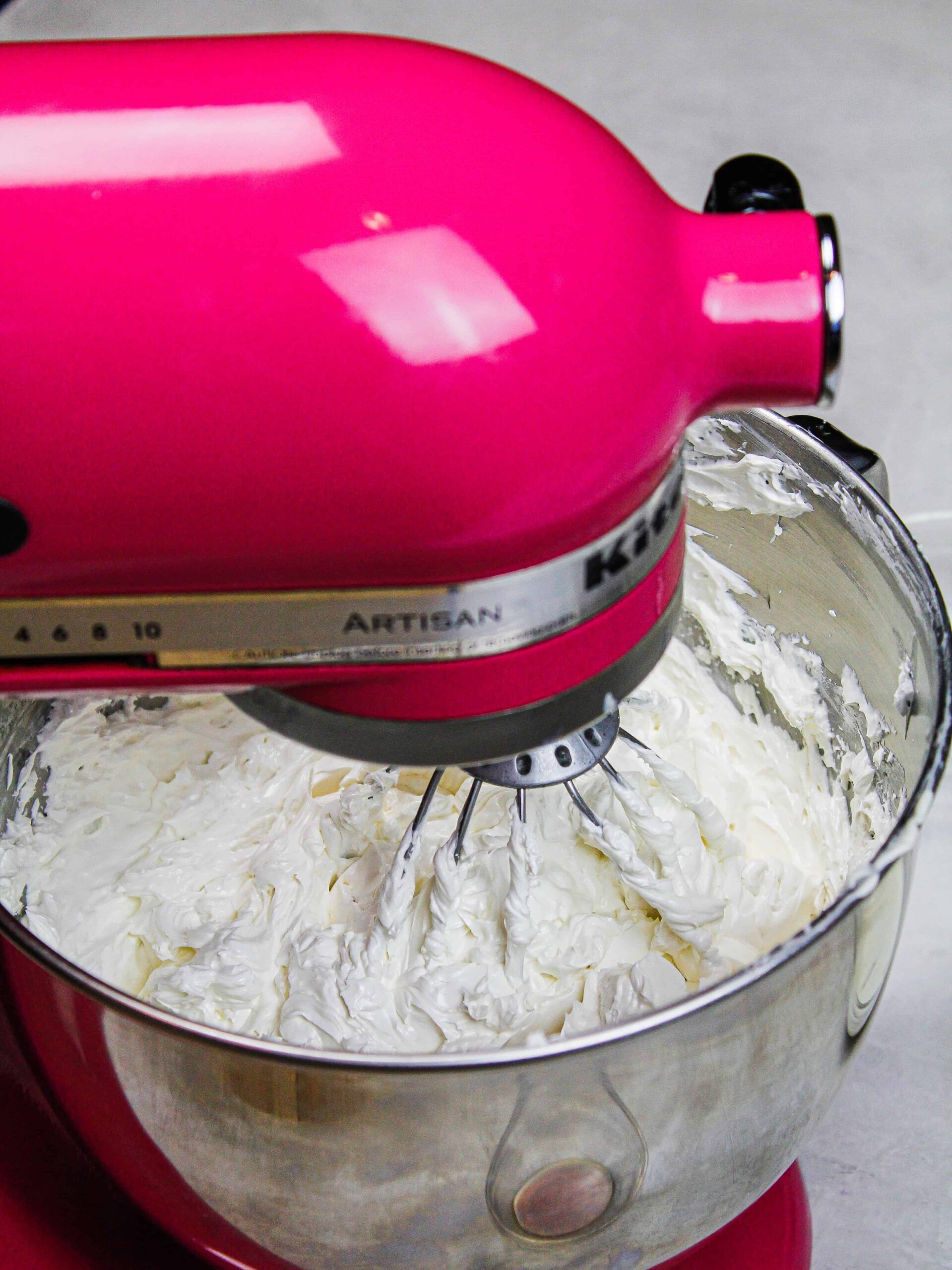
Over the years I’ve found that I prefer mine with a bit more salt and slightly more butter than most Swiss meringue buttercream (SMBC) recipes call for.
How to Make Swiss Meringue Buttercream
While half the battle of SMBC is having a good recipe, the other half is how you make it! That’s why walk through everything you need to know to make the smoothest, fluffiest Swiss meringue buttercream frosting in this post. I also share a video of the process below.
Step #1: Separate the Egg Whites
What gives this frosting its incredible texture is the meringue that it’s made with. That’s why the eggs in this recipe are so important. Or more specifically the egg whites!
If you’re not quite sure what to do with the 7 egg yolks you’ll be left with after making this frosting, here’s a great post with loads of ideas for using up leftover egg yolks.
Separate your eggs when they’re cold! It makes it way easier to do and they’ll be heated before being whipped so there’s no reason to bring them to room temperature ahead of time.
Be careful as you do this, because they won’t whip up properly if any yolk gets into the mixture!
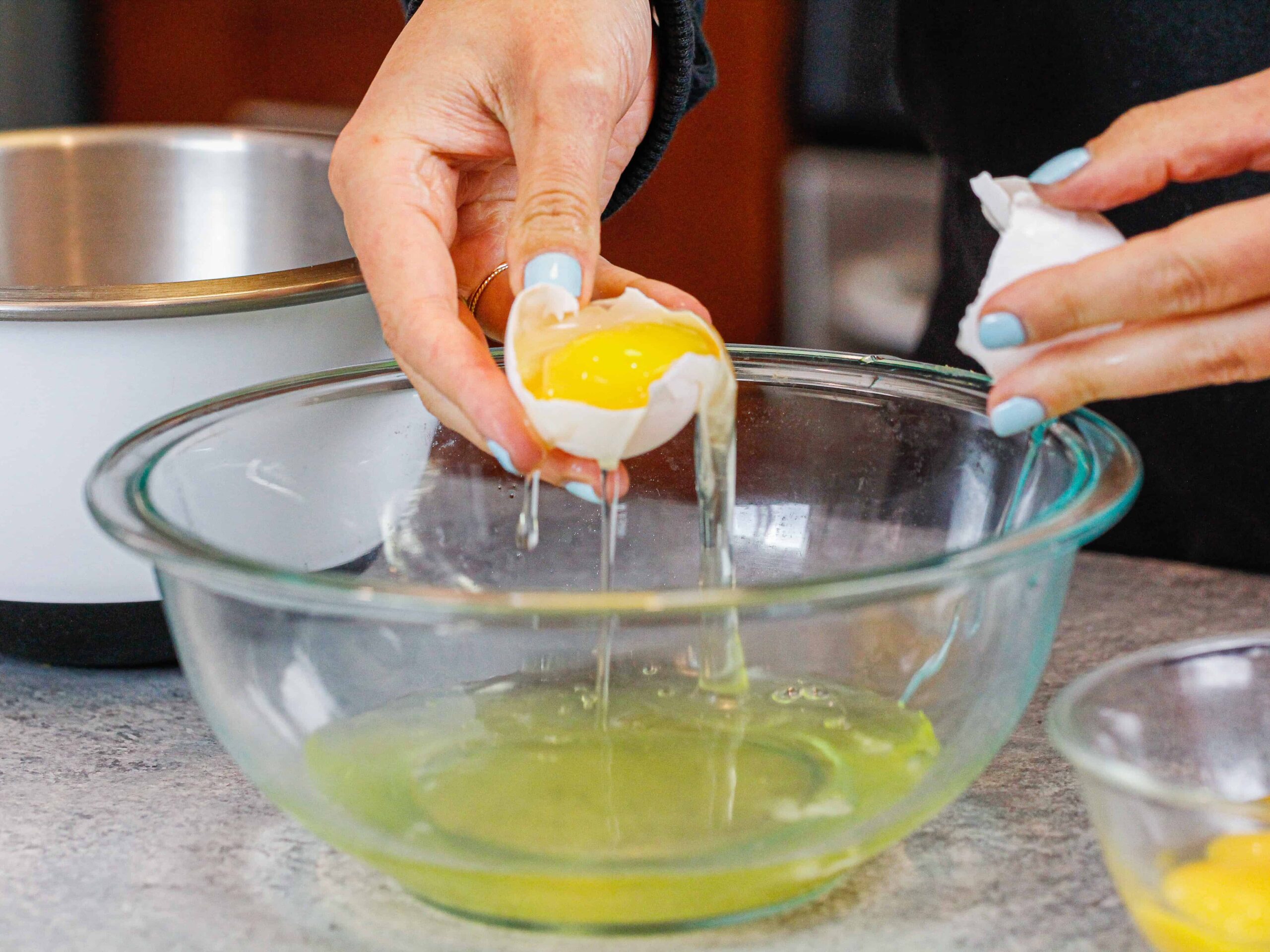
Normally I’m a huge fan of using egg whites out of a carton, but that’s when I’m adding them into a batter. When it comes to making meringue, I find that carton egg whites simply don’t whip up as well.
I really struggle getting stiff peaks with them. The pasteurization process weakens the proteins in the egg whites and makes them so much harder to whip up. I don’t recommend using egg whites from a carton to make Swiss meringue frosting.
Step #2: Heat Up the Egg Whites & Dissolve the Granulated Sugar
There’s something about the idea of adding raw eggs into frosting that seems a bit creepy. A lot of people worry it isn’t safe to eat, but we take an important step to ensure it is!
By heating up an whisking our egg whites and granulated sugar over a double boiler to 160 F / 71 C, we accomplish two things at once.
The first is that we kill any potentially harmful bacteria. Salmonella is instantly killed at this temperature.
The easiest way to ensure your mixture gets hot enough is to use a digital thermometer. This helps you know exactly when your egg whites are warm enough and prevents you from overheating them.
If you don’t have a digital thermometer on hand, you can test with your finger. The mixture should be quite warm to the touch, but not hot enough to burn your finger.
This step also dissolves the granulated sugar, which gives the frosting a silky-smooth texture.
It’s very important that the sugar is fully dissolved before you make the meringue, or else your frosting can end up with a grainy texture.
A great way to know if the mixture is ready if you don’t have a thermometer is to test it with your fingers! Take a tiny bit of the warm liquid between your forefinger and thumb and rub them together.
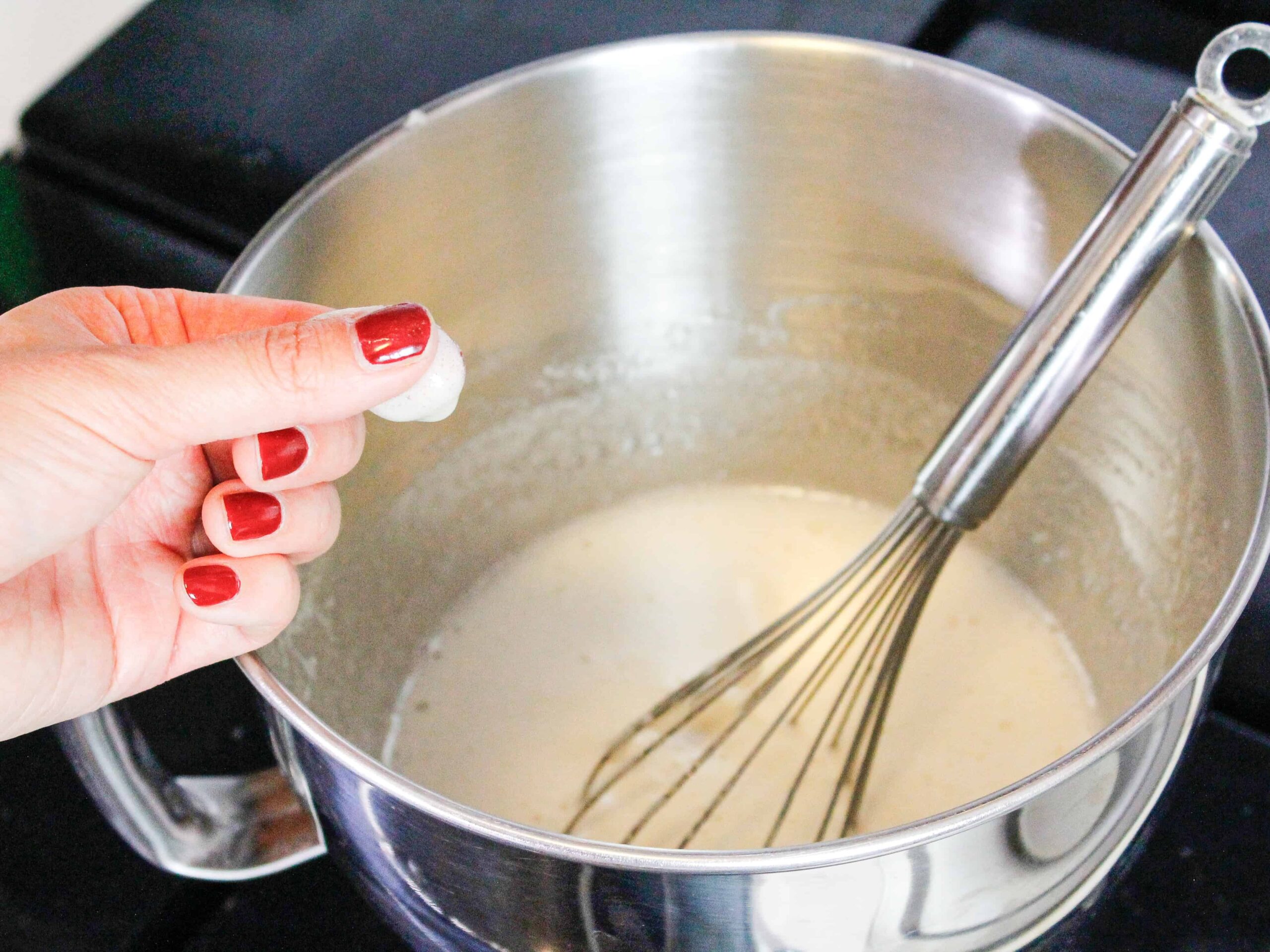
The mixture should be smooth, and you shouldn’t be able to feel any sugar granules. If you do, I suggest heating your egg white/sugar mixture a bit longer then testing again to make sure it’s smooth.
Step #3: Whip the Swiss Meringue to Stiff Peaks
Once your sugar is fully dissolved and your mixture is smooth, it’s time to whip it into a meringue to stiff peaks. This takes quite a bit of time!
I find it can take 5-10 minutes of mixing with a whisk attachment on a medium-high speed.
You can also make this Swiss meringue with a hand mixer, but it would take forever!! Making it with a stand mixer is much easier and quicker.
Stiff peaks should look like my whisk below, where the meringue can stand up on its own when flipped upside down.
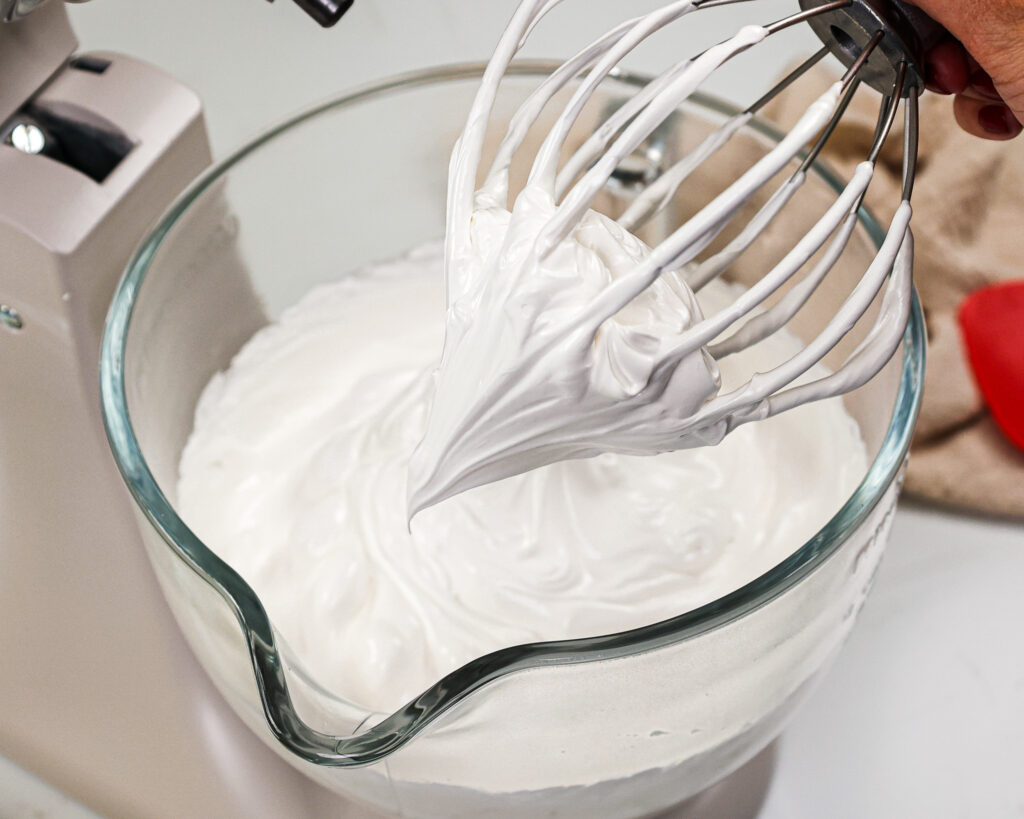
It can be hard to tell when the meringue reaches this stage just by looking at your mixing bowl, so feel free to take breaks and test it by removing your whisk attachment.
Doing so won’t have a negative impact on your meringue. It just helps make sure you get the consistency just right without over mixing your meringue.
Step #4: Adding in the Butter, Vanilla and Salt
Once your meringue has stiff peaks, it’s time to mix in the unsalted butter.
After all that mixing, you’d think your bowl would have fully cooled off, right? But you might be wrong! At this point in time, I like to feel that bottom of my bowl with my hand.
If it feels pretty much room temperature, I add in the butter. If it still feels warm, I’ll either wait another 15 minutes to add the butter or pop my bowl into my fridge for 5 minutes to help it cool down.
Usually by making sure the meringue and bowl have cooled to room temperature, you can prevent your Swiss meringue buttercream from becoming too thin or soupy.
When I do start to add in my unsalted butter, I add it in one stick at a time. This gives your meringue time to incorporate the butter, and helps it mix more easily.
As you add the butter, it’s super important that your butter is room temperature. This does NOT mean soft to the touch or greasy.
It should be soft enough for you to be able to press your finger into, but firm enough that you have to apply a bit of pressure to do so.
The time it takes for a stick of butter to come to room temperature can vary based on the type of butter you use and the temperature and humidity of your kitchen.
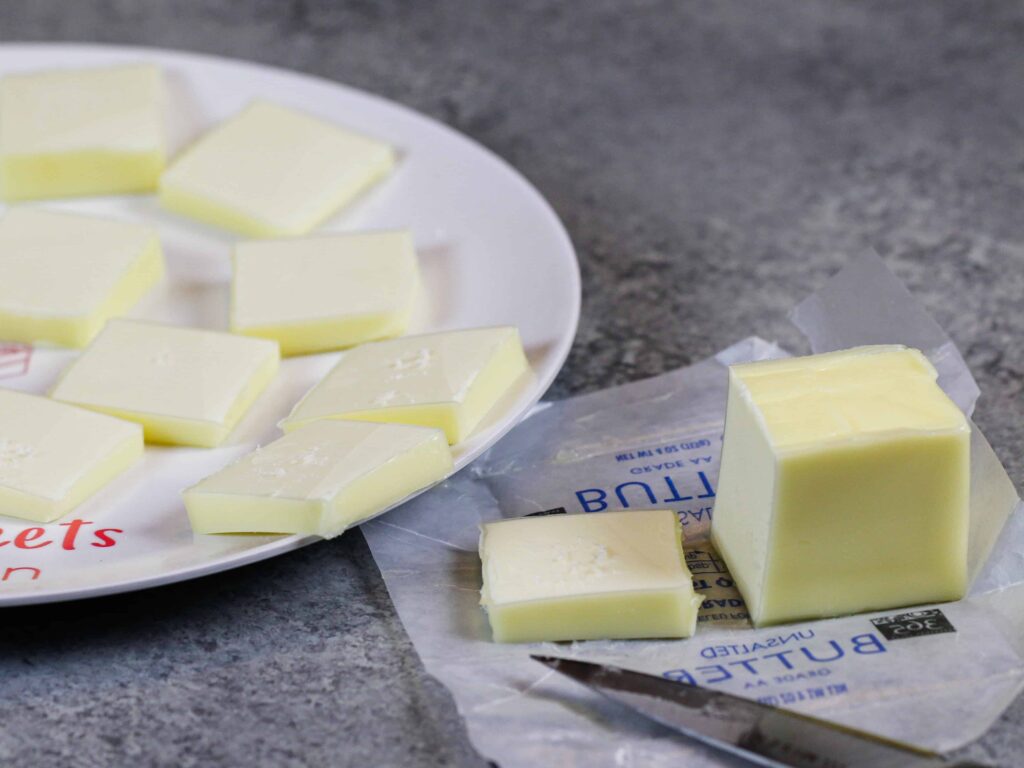
In my kitchen it usually takes 1-2 hours (1 in the summer, 2 in the winter).
Once the butter is mixed in, add in the vanilla extract and fine salt and mix until combined.
Step #5: The Attachment Switcheroo
When all the ingredients are mixed in, it’s time to swap out your whisk attachment.
While we want our buttercream to be fluffy and light in texture, we also want it to be smooth.
Whether you plan to spread your frosting onto a cake or pipe with it, your frosting needs to be smooth and air bubble free.
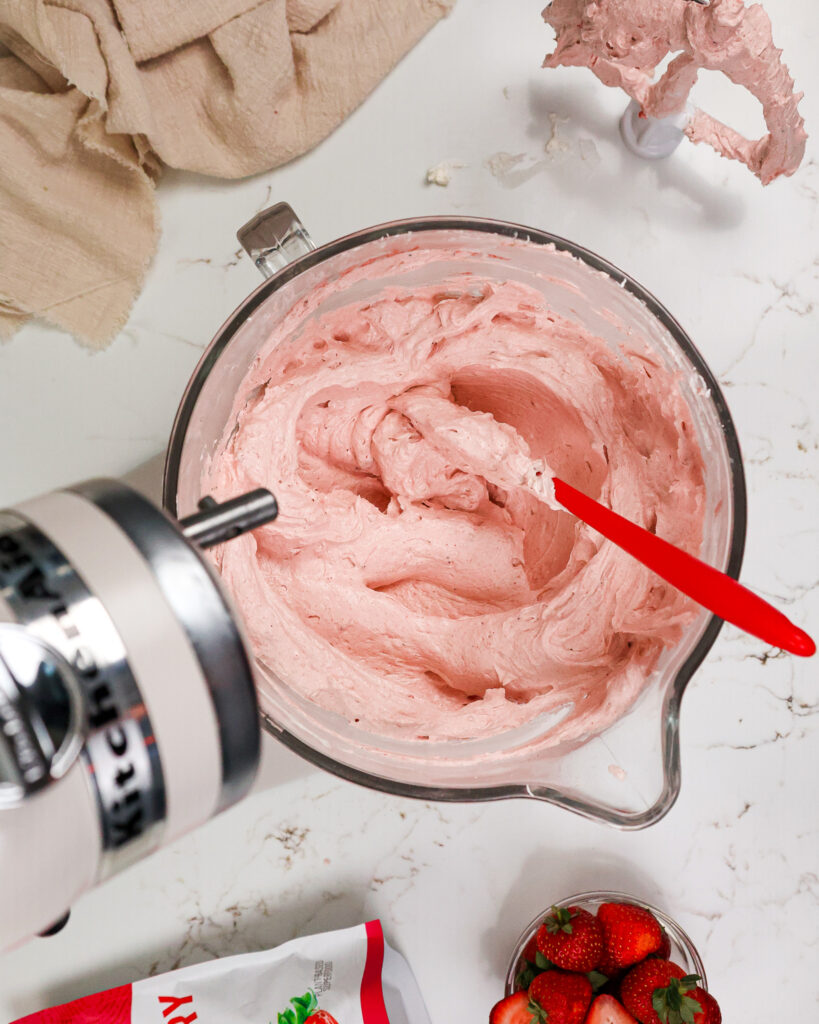
I find that mixing the finished buttercream on a low speed with a paddle attachment for a few minutes makes a world of a difference. It makes it so much easier to smooth onto cakes!!
Swiss Meringue Buttercream Troubleshooting
Two of the most common issues people run into when making this type of buttercream are curdled or soupy frosting.
While it might seem terrifying to watch your frosting seem to fall apart, fear not. Both problems are actually pretty easy to fix!!
How to Fix Curdled / Broken Swiss Meringue Buttercream
A lot of different things can cause your SMBC to break or curdle.
Maybe your butter was too cold, or your kitchen was too chilly. Maybe you were thawing a batch of buttercream made in advance, and it hadn’t fully come to room temperature before you started mixing it.
Whatever the reason, your frosting looks chunky, dense, and greasy.
But don’t worry, your frosting isn’t ruined! There’s an easy work around that will bring your frosting back together.
Simply place your bowl over a hot water bath / double boiler until the frosting around the edge of the bowl has melted. Then give it a good mix for several minutes.
The melted, warm buttercream around the edge of the bowl will mix with the frosting that’s too cold. This will bring the overall temperature of the buttercream up to the right temperature and allow it to become smooth again.
How to Fix Soupy Swiss Meringue Buttercream
On the other hand, if your frosting is too warm it might become a soupy, runny mess. This can happen if your meringue is too warm when you add the butter, if the butter is too warm, or if your kitchen is too toasty!!
If the buttercream isn’t sturdy enough to keep its shape, you need to cool it down. To do this, just pop the mixing bowl and whisk right into the fridge.
Chill the bowl for 10-20 minutes. At this point the center might still be a bit soupy, but the buttercream along the sides of the bowl should be firmer. Then mix it for a few minutes to see if it comes together.
If after 3-4 minutes of mixing it still looks too soft, chill the bowl for another 10 minutes before mixing it again. That usually does the trick!
Coloring Swiss Meringue Buttercream Frosting
The last thing I want to touch on is coloring Swiss meringue buttercream frosting.
This type of frosting is a bit more difficult to color than American buttercream. To make it bright and colorful, gel food coloring is a must.
My favorite gel food coloring is Americolor, and it’s the only food coloring I use.
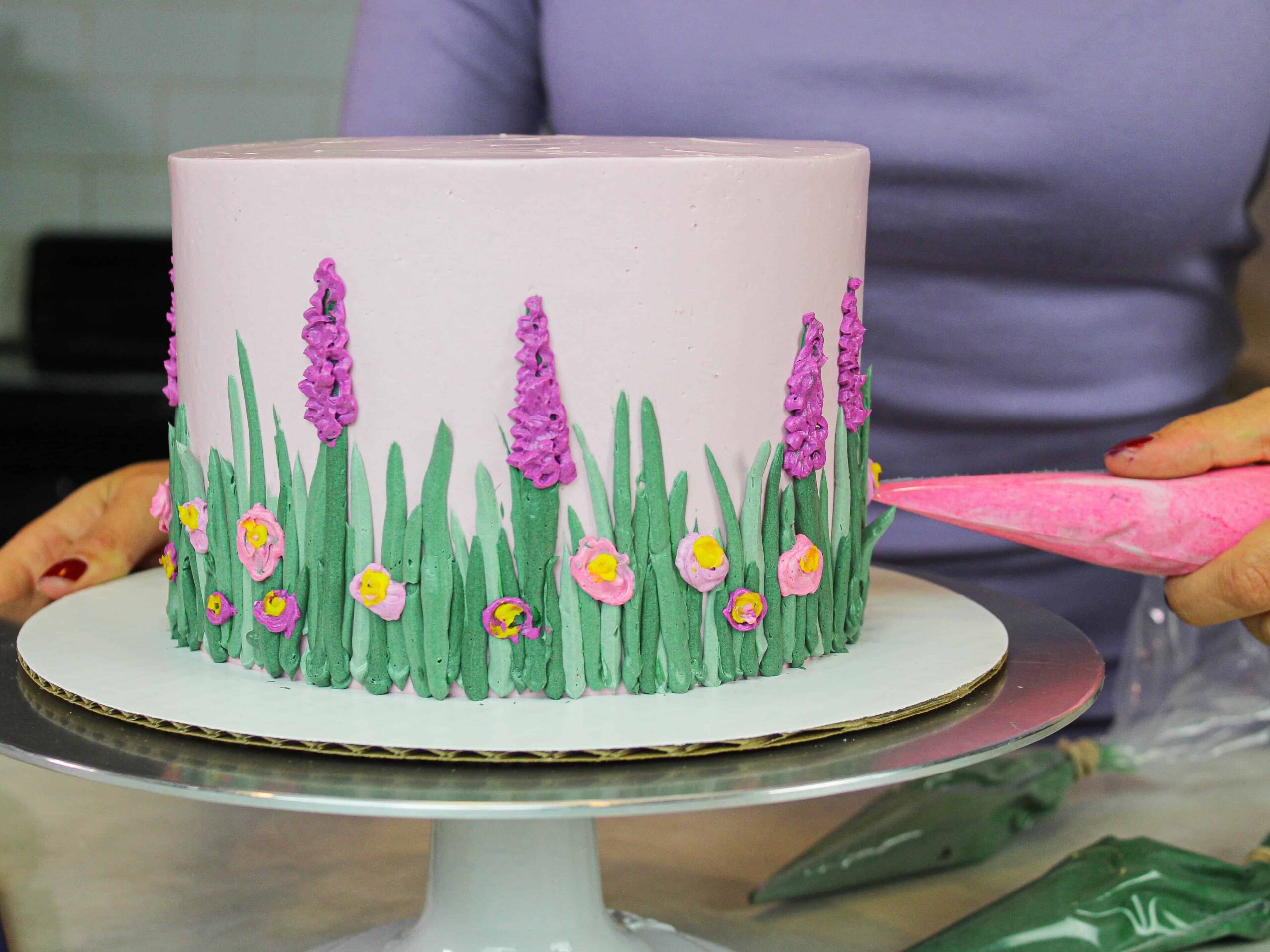
Even with gel food coloring, I have to use quite a bit to get my colors really vibrant.
If you want to make deep or really intense colors, I highly recommend making your frosting in advance. The color of the frosting will deepen overtime!
Tips For Making Best Swiss Meringue Buttercream Frosting
- Wipe down your tools with lemon juice or vinegar to make sure they’re grease-free. Traces of grease in your mixing bowl can prevent your meringue from forming stiff peaks!
- Separate your eggs when they’re cold! It makes it way easier to do and they’ll be heated before being whipped so there’s no reason to bring them to room temperature.
- Heat your egg white / sugar mixture to 160 F / 71 C and check to make sure all the sugar is dissolved before removing it from the double boiler.
- Whip the meringue until your peaks are stiff enough to defy gravity.
- Make sure your butter is actually at room temp and add it in slowly (1 stick at a time).
- When in doubt (if your frosting breaks / curdles), just keep mixing!! It should come back together with the help of your stand mixer.
- Mix your finished buttercream on the lowest speed with a paddle attachment for a few minutes to make it smooth.
- Note: 1 batch of frosting is enough to fill and frost a seven- or eight-inch layer cake.
Making This Swiss Meringue Frosting in Advance and Storage Tips
Make your buttercream ahead of time or save any leftover frosting! It can be stored in an airtight container at room temperature for up to 8 hours, in the fridge for up to a week, or in the freezer for up to 3 months.
Be sure to give it a good stir once it thaws to room temp to get the consistency nice and smooth again.
A frosted cake can last in the fridge for up to a week, or in the freezer for up to a month. The buttercream locks in all the moisture, keeping the cake fresh and delicious!
If you cut into the cake and have leftovers, use any remaining frosting to cover the cut section to keep it moist and store in the fridge for up to a week.
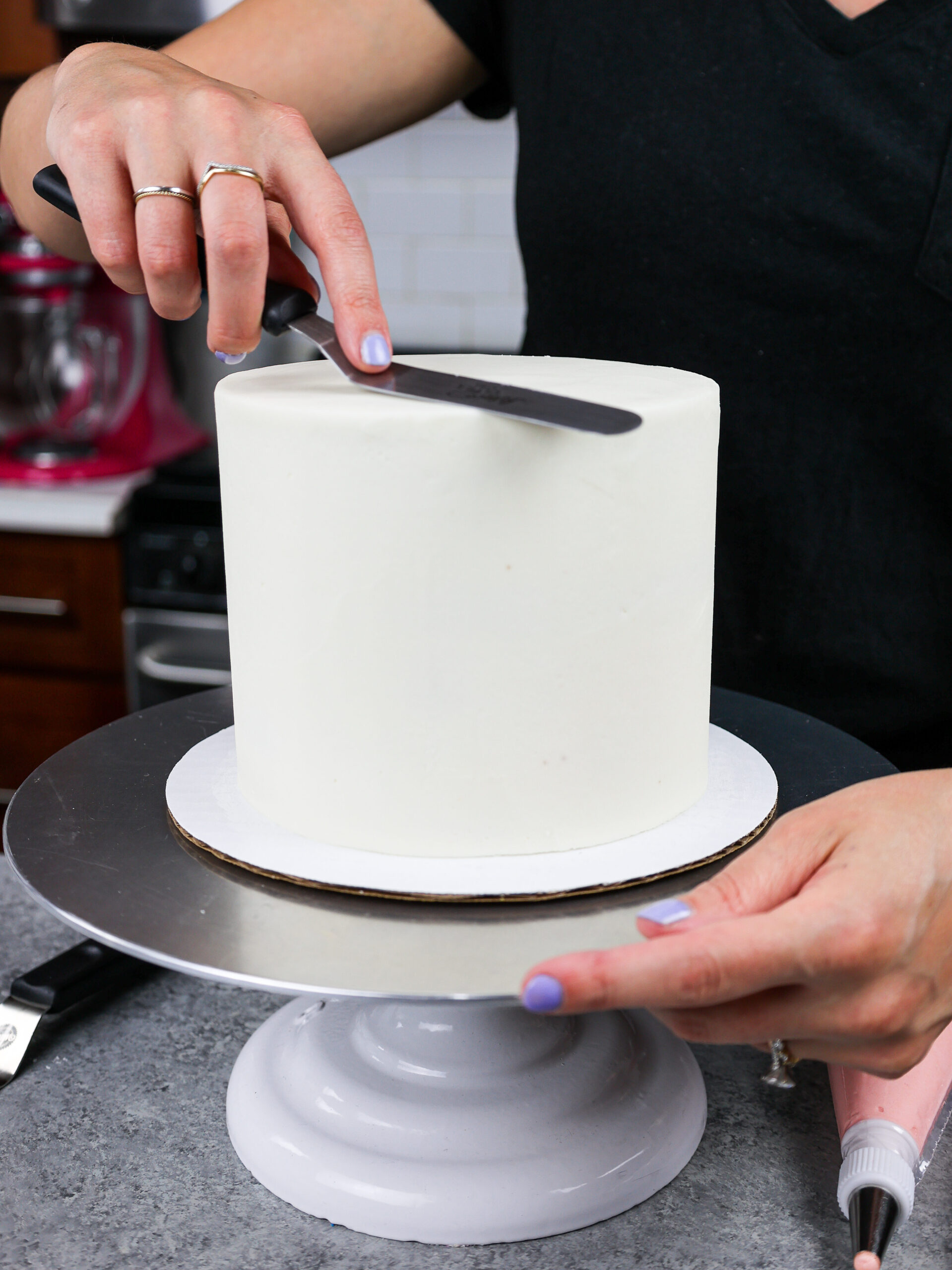
Let Me Know What You Think!
If you try this recipe for Swiss meringue buttercream frosting, I’d love to hear what you think of it! Please leave a rating and comment below.
Tag me @chelsweets and use #chelsweets so that I can see your amazing creations on social media!
Other Recipes You Might Like:
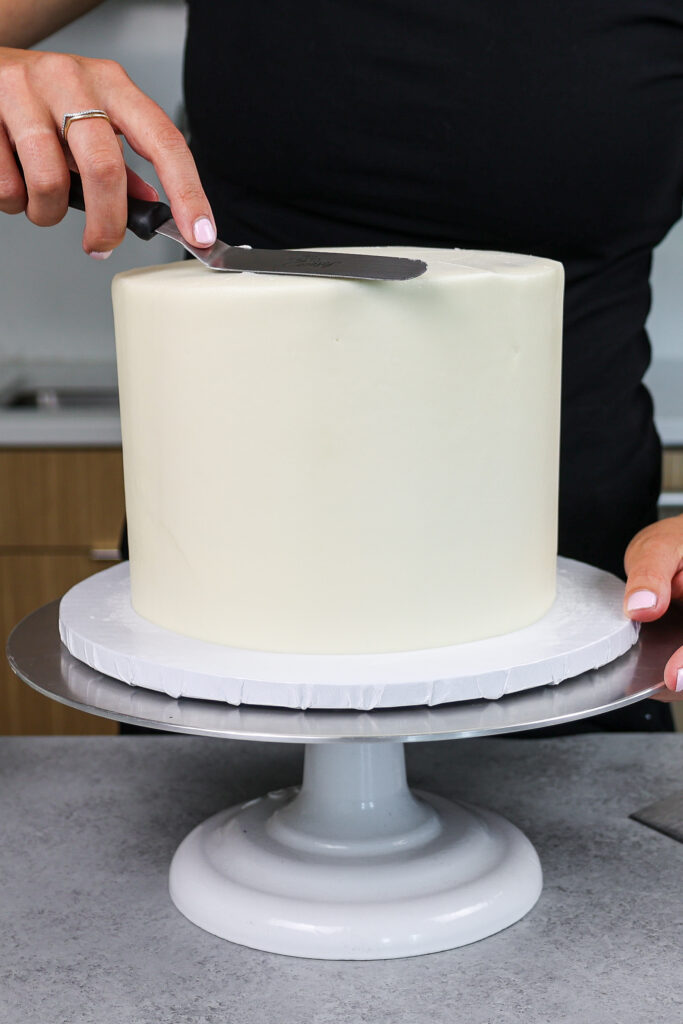
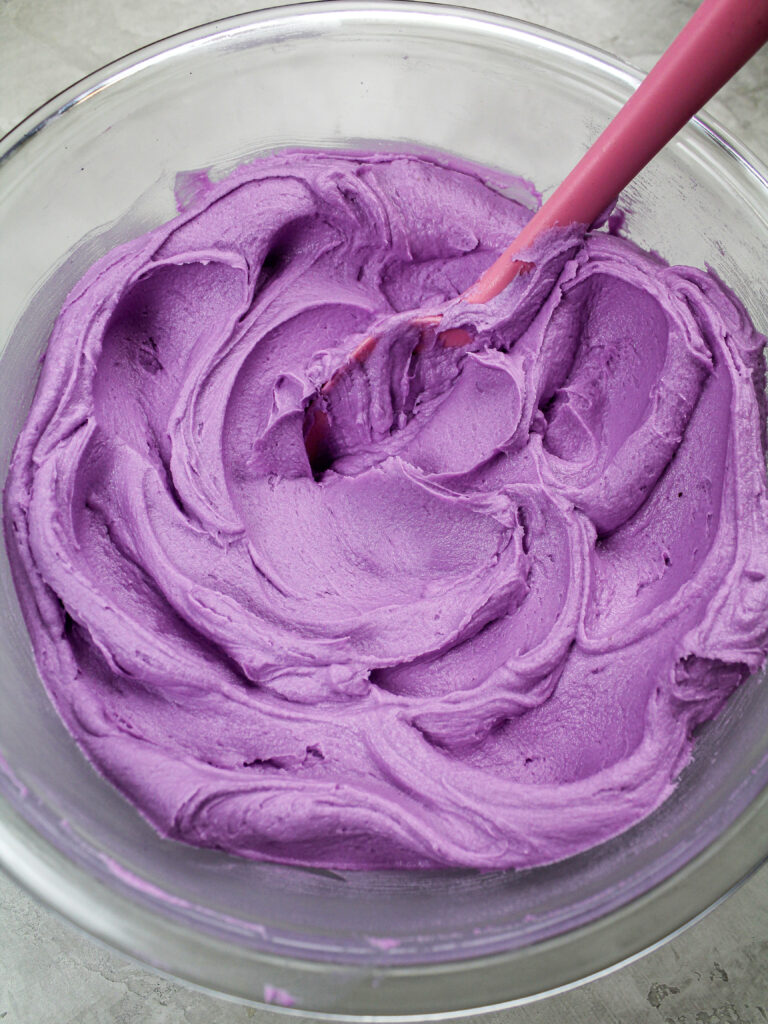
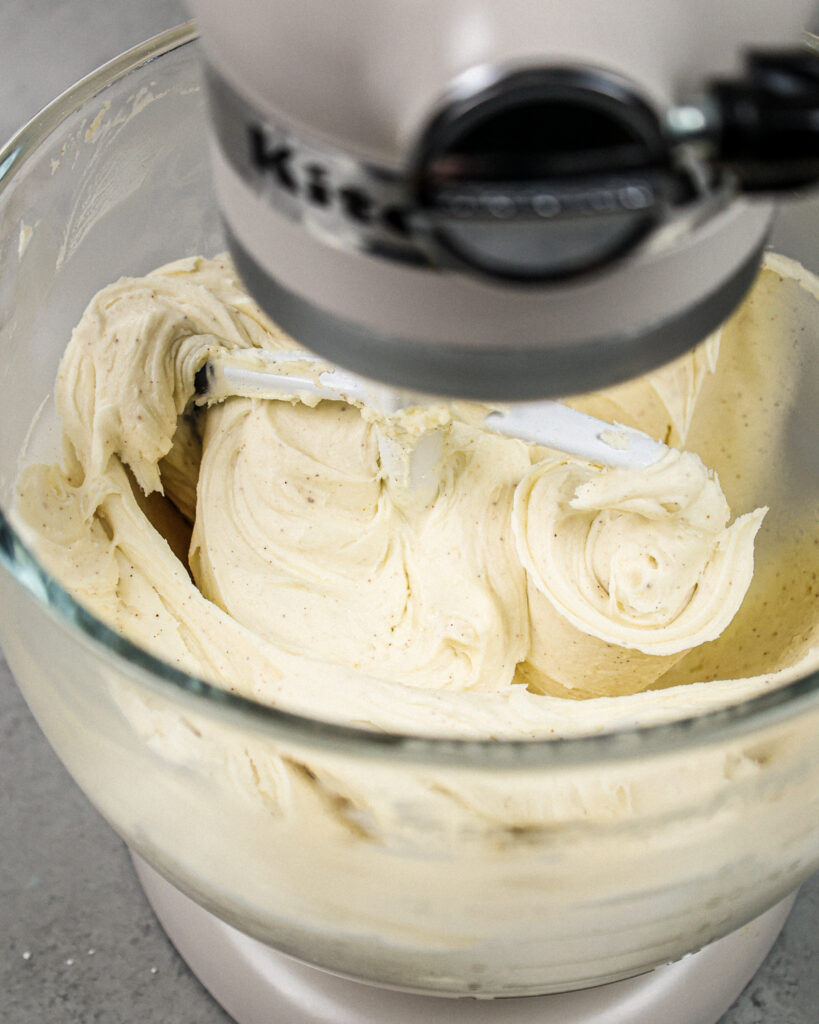

Swiss Meringue Buttercream Frosting

This Swiss meringue buttercream is made with fluffy meringue and has the perfect balance of sweetness and richness!
Ingredients
- 7 large egg whites (235g)
- 2 cups granulated sugar (400g)
- 2 cups unsalted butter, room temperature (452g; 1 lb. box)
- 2 tsp vanilla extract (8ml)
- 1/2 tsp fine salt (3g)
- gel food coloring (if desired)
Instructions
- In a medium sized pot, add about 1-inch of water and bring to a simmer.
- Before making the frosting, be sure to thoroughly clean the mixing bowl. If there’s any grease it can make it difficult to make the meringue.
- Add the egg whites and granulated sugar into the mixing bowl and place the bowl on top of the pot filled with simmering water. The bowl should create a seal over the pot. Make sure the water isn’t actually touching the bottom of your bowl.
- Whisk the mixture constantly for about 3 minutes, until it reaches 160 F/ 71 C. You can test the mixture to see if it’s ready by rubbing a tiny bit between your fingertips. The sugar should be fully dissolved, and it should feel super smooth and hot to the touch.
- Lift your bowl away from the pot and dry the bottom with a towel. Lock the bowl into place on your stand mixer and beat on medium high using a whisk attachment. Mix for 5-10 minutes, or until you have stiff and glossy peaks. At this point the bowl should be back to room temperature and no longer warm to the touch. If it’s warm, it will melt your butter!!
- Once bowl is at room temperature, slowly mix in the unsalted butter on a medium speed.
- Add in the vanilla extract, salt and gel food coloring (if desired) and mix on a low speed until fully incorporated.
- The frosting should have a thick, whipped consistency at this point. If it looks lumpy or broken, keep mixing until it looks smooth and thick.
- To make the frosting extra smooth, swap out the whisk attachment for a paddle attachment and continue mixing on a low speed for a couple minutes.
- Use on everything from cakes to cookies!! It pipes like a dream and is also great for filling layer cakes.
Notes
Tips for Making the Best Swiss Meringue Buttercream
- Wipe down your tools with lemon juice or vinegar to make sure they're grease-free. Traces of grease in your mixing bowl can prevent your meringue from forming stiff peaks!
- Separate your eggs when they're cold! It makes it way easier to do and they'll be heated before being whipped so there's no reason to bring them to room temperature.
- Heat your egg white / sugar mixture to 160 F / 71 C and check to make sure all the sugar is dissolved before removing it from the double boiler.
- Whip the meringue until your peaks are stiff enough to defy gravity.
- Make sure your butter is actually at room temp and add it in slowly (1 stick at a time).
- When in doubt (if your frosting breaks / curdles), just keep mixing!! It should come back together with the help of your stand mixer.
- Mix your finished buttercream on the lowest speed with a paddle attachment for a few minutes to make it smooth.
- Note: 1 batch of frosting is enough to fill and frost a seven- or eight-inch layer cake.
Making This Swiss Meringue Buttercream in Advance and Storage Tips
- Make your frosting ahead of time or save any leftover frosting! It can be stored in an airtight container at room temperature for up to 8 hours, in the fridge for up to a week, or in the freezer for up to 3 months.
- Be sure to give it a good stir once it thaws to room temp to get the consistency nice and smooth again.
- A frosted cake can last in the fridge for up to a week or in the freezer for up to a month. The buttercream locks in all the moisture, keeping the cake fresh and delicious!
- If you cut into the cake and have leftovers, use any remaining frosting to cover the cut section to keep it moist and store in the fridge for up to a week.
Nutrition Information
Yield
6Serving Size
1Amount Per Serving Calories 825Total Fat 61gSaturated Fat 38gTrans Fat 0gUnsaturated Fat 20gCholesterol 163mgSodium 170mgCarbohydrates 67gFiber 0gSugar 67gProtein 5g

Niamh
Friday 11th of November 2022
My buttercream is both soupy AND curdled! ??
Chelsweets
Saturday 12th of November 2022
Hi Niamh,
Oh no!! Sometimes this frosting can become thinner as it curdles. I'd recommend following the steps listed above to help it warm up a bit! That should help it come together <3 Hope that helps for next time and that you were able to get this batch to work out. Happy baking!
Blackberry Mousse Cake: Delicious Recipe Bursting with Berries
Friday 9th of September 2022
[…] you want to use a less sweet frosting, I’d recommend making a batch of my Swiss meringue buttercream or my hybrid […]
Hocus Pocus Cake: Easy Recipe w/ Step-By-Step Video Tutorial
Saturday 3rd of September 2022
[…] you want to use a less sweet frosting, I’d recommend making a batch of my Swiss meringue buttercream or my hybrid […]
Bubblegum Cake: Delicious Recipe & Step-by-Step Tutorial
Friday 5th of August 2022
[…] you want to use a less sweet frosting, I’d recommend making a batch of my Swiss meringue buttercream or my hybrid […]
Taco Cake: Easy Recipe & Step-by Step Tutorial - Chelsweets
Saturday 23rd of July 2022
[…] you want to use a less sweet frosting, I’d recommend using a batch of my Swiss meringue buttercream or my hybrid […]